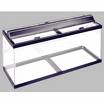
A bare aquarium with fishes but no plants is like a house without a kitchen: fully furnished but unliveable. Only plants bring that magical feeling of calm and nature to the aquarium. Most aquarists know this but are helpless when their freshly purchased plants become fodder for the fish or the leaves turn brown and wither.
The trick to get it right is in choosing fishes that don't eat plants. Easier said than done, but there are a number of fishes that keep off plants. Ask the pet shop dealer and he will help. Then get the plants right. Don't go for the fancy cobomba, Amazon sword leaf, which are pretty demanding in terms of light, nutrients and water conditions. Select vallesneria or hydrilla or some other plants, which are non-demanding. You should have substrate that is at least four inches deep at the rear, so that plants can grow roots. Plant them in such a way that the crown is out and the roots are in. If you cannot afford expensive lighting, place your aquarium at a place where sunlight streaks can reach for at least an hour.
Watch your plants grow, bubbling with life.
~S.N.




